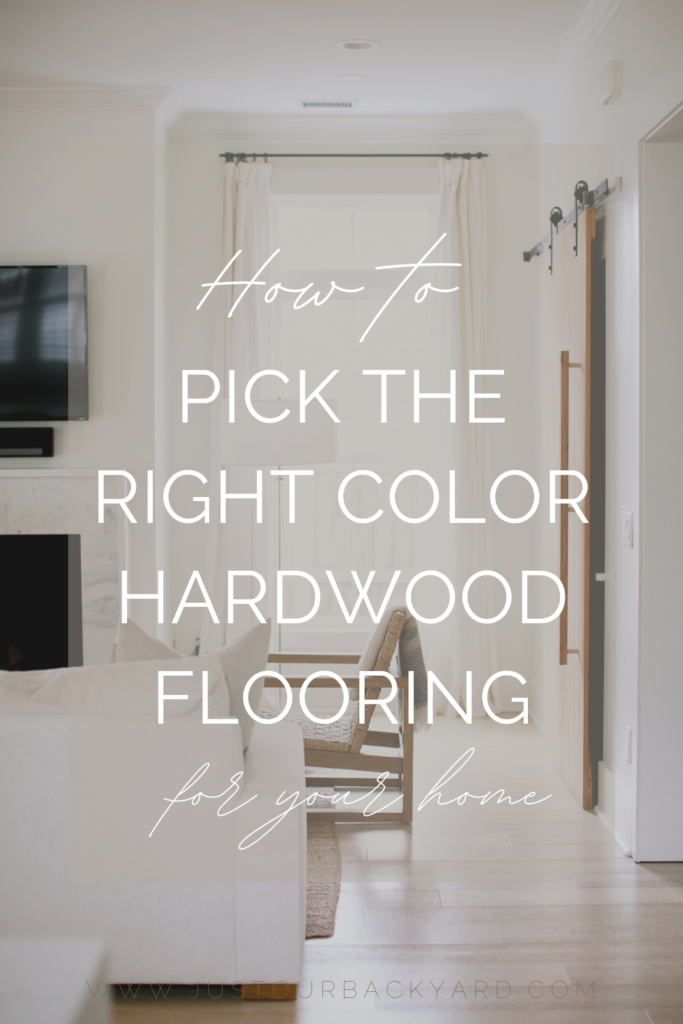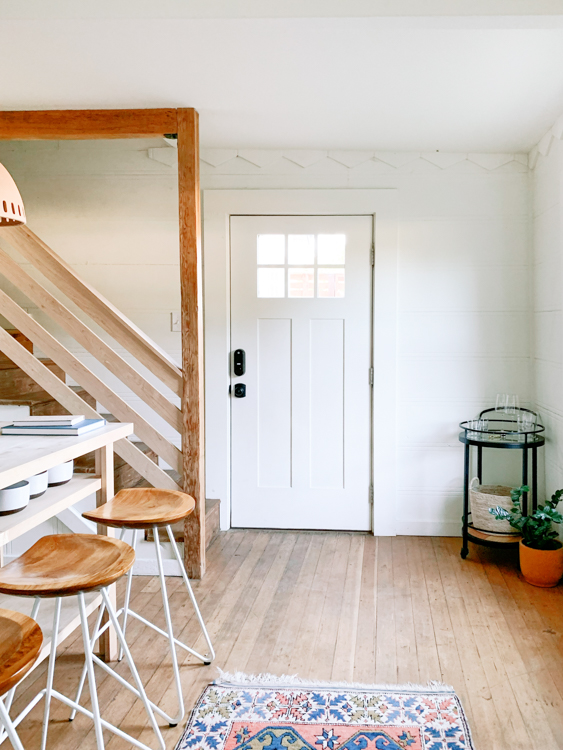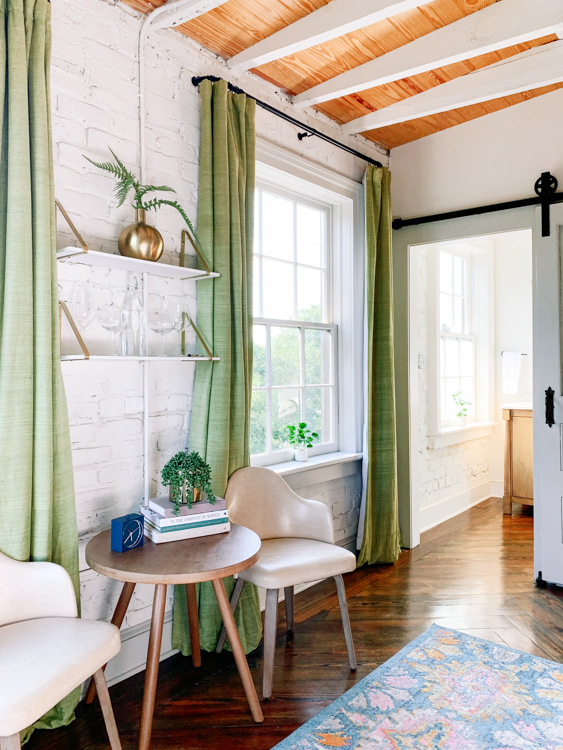Well, after living in this house for nearly three years, we finally are ready to go forward with installing hardwood floors. But first came choosing a hardwood floor color. When I first started looking into wood flooring over a year ago, I had NO IDEA how many colors were out there. Talk about complete overwhelm! Not to mention, I’m making color decisions with a husband who is color blind…. You can imagine how easy choosing the right hardwood floor color has been.
In my painstaking process of choosing a hardwood floor color, I found a handful of things that I knew could be helpful for others. It took me WAY TOO LONG (like over a year) to decide on a color because I didn’t know a lot about the simple things I’m about to share. Figuring out what inspires you, considering the lighting, getting familiar with tones/undertones, considering species/grain, and grabbing all the pretty samples as you go forward are the most important tips for choosing the right hardwood floor color .
Choosing a hardwood floor color doesn’t have to be overwhelming with these simple tips.

They are useful when choosing any flooring color really and can be applied to solid hardwood, prefinished hardwood flooring, stain colors for wood floors, engineered hardwood, and even luxury vinyl or tile wood-look flooring. These are simple everyday design principles that are incredibly useful for homeowners like you and me!
My hope is that these 5 tips will save you time, money, and overwhelm when choosing the right hardwood floor color for your space… After all, these are tips for the everyday busy homeowner who is passionate about creating (or living in) functional, timeless, beautiful spaces!
So let’s get into it!
Tip 1: Figure Out What Inspires You
Taking the time to find the home decor styles that resonate with you is so important! Finding your “design style” will help not only with but also with any other home renovation or design projects you may plan going forward. This step alone is the most important and time saving.
How do I figure out what inspires me?
The simplest and most foolproof way to figure out what inspires you and define your design style or vision is to look at your Pinterest pin boards. Chances are you’ve already been pinning. If you haven’t that’s the next fun step!
Gather inspiration.
Pin, pin, pin! Pin anything and everything that inspires you (or collect from magazines). It does not have to just be homes, rooms or home decor. I always have nature and texture type images on my pin boards! Use what inspires you.
Start paying attention to the rooms you gravitate toward. Look at your PIN boards, home magazines, or shows and designers that you love. Chances are they have more similarities than you realize!
What elements keep repeating?
Look at your boards on a wider scale instead of one by one. Don’t try to reinvent the wheel, emulate those design elements and focus on recreating that. It’s obviously what you love… so when you go shopping you won’t get distracted with something totally different that what you’re trying to create. Your design style and plan will help you stay focused.
Ask yourself:
- What types of rooms and styles do I love?
- What wall colors, flooring colors, accessory colors and other elements do they have in common?
How do you want your space to make you feel?
What the heck does that mean? If you’re like me I didn’t really know… I had to do some digging! Here’s what I found helped me. Consider these mood words.
- Casual, inviting, cozy, moody, warm, safe, rich, bright, airy, authentic, restful…
- Or complete the sentence, “When my guests (or family members) walk into this room, I want them to feel …”
Look at your mood board or pins on Pinterest. You want the room to tie together as a whole. The flooring should coordinate and compliment the rest of the room. your flooring and wall colors will be the backdrop!
Compile your favorites.
If you don’t already have a room specific vision or design plan, I recommend creating a mood board from the info you gather during this step. This will save you time and brain space and will act as the “design plan” that you can refer back to at any given time you decide to do a little updating or renovating.
This one tip will help you not only with how to choose the best hardwood floor color but how to make every other design decision for the space going forward. Our other 4 tips build off of this one!

Tip 2: Consider the Lighting
What is the lighting like in the rooms that your flooring will be in? What times of day or night do you spend the most time in that room?
Lighting is one of the most important elements that will affect your space when choosing a hardwood floor color.
Natural or Artificial Light.. or both!
Is there a lot of natural light or not? Less natural light in the space will mean that dark tones will look darker and a lot of natural light could mean light tones appearing stark or sterile. If you’re loving a dark espresso hardwood floor stain but are concerned with it appearing too dark, you could most likely get away with it in a room with ample natural light.
Temperature & Intensity
Lighting temperature in intensity changes throughout the day. Note the lighting at those times. Does the light appear warmer or cooler, is it natural light or artificial light (lamps, overhead fixtures), is it intensely bright or muted?
Tip 3: Get Familiar with Tones and Undertones
What in the world are tones and undertones?
Tones: Whether a color is light, medium or dark.
Undertones: Underlying colors in the stains, wood species, grains Etc that will affect the final color. Can be warm, neutral, or cool.
Cool Undertones:
Cool undertones are those that have underlying greens, blues, or purple’s. Many greys and blacks lean cooler, though there are warmer greys (think beige).
Cool undertones often are found in more modern and industrial design styles.
Warm Undertones:
Warm undertones have Reds oranges and yellows. Think cherry wood or Red Oak.
These are often found in historical, old world and traditional design styles.
Neutral Undertones:
Neutral undertones Lean less toward one or the other. Thank White Oak with a clear sealer on top. Raw, rustic wood is also an example of this. Neutral undertones are highly versatile and can be used in many design styles. I went this route because I wasn’t sure what my design style would be at this point!
What tones and undertones are most apparent in the rooms that inspired you from your Pin boards or inspirations? Some of the most popular hardwood floor colors right now are grey, espresso, and bleached tones in neutral undertones! Many of the images you’ll come across will feature those.
Tip 4: Consider the Species and Grain of the Wood
If you haven’t already guessed it, wood undertones can be either warm or cool.
- Pine wood can look yellow or orange and red oak, you guessed it, can read red (with just a sealer on it, no stain)…. All warm. White oak has more neutral undertones when it is raw and clear sealed, but that changes if a stain color is applied.
Different species of wood take stain differently and have different undertones and grain.
In my opinion, white oak flooring with a clear sealer is the most timeless hardwood floor color. Coming in second is probably a red or white oak floor with a medium brown or gunstock stained finish. These two options or what you’ll often see in historic buildings or homes that want a timeless feel and they age beautifully over time.
More grain results in more color variation and this varies by wood species. For example, Hickory has a large variation in grain and tone. You won’t be able to see a lot of variation in one small sample. So that leaves us to tip number 5.

Tip 5: Get Samples and Live with Them for a Bit
Get lots of samples. Large samples if you can of the woods that have variations. Not only of different colors, but also get multiple samples of the same style so you have an idea of the variations the color has on the grain.
Lay them in the room you want the flooring in and live with them for a few days or weeks. Pay attention to them in the various lighting and times of the day. Move them around. See them against your furniture, with that Cozy Corner lamp on, with the early morning light pouring in through the window… You get the picture.
Eliminate the colors you don’t love.
Ruthlessly remove samples from the group you have laying out. As the day goes on and you see the samples under the varying light in your home, you’ll be able to eliminate ones that aren’t the look you’re going for. Don’t be afraid to return to the store for entirely different samples before making your final decision! Choosing the right hardwood floor color is one of the most important decisions you’ll make in this process. The most popular hardwood floor colors are the easiest to get samples of, though you can always order samples of any other color. You may have to pay a small fee for samples of flooring or stain but I promise you it’s worth it!
A flooring color you love in the store, may look awful once you get that sample home and look at with your furnishings and wall colors. I personally found a neutral wood color (spiced brown) that I loved! However, once I got it home, I realized it was the exact same tone as the vinyl wood-look flooring that the previous owners installed… which I hate! I would have been really upset had I went with that. I’m so glad I decided on the timeless white oak with no stain, only a clear finish. I’ll share that in another post once we actually get to working on the project!
Choosing the right hardwood floor color. How hard can it be to choose a hardwood floor?
Ha! What a loaded question. When I was trying to figure out the color I wanted, I read a NY Times article with the same title… apparently I wasn’t alone in being neck deep in overwhelm with all of the options! There are thousands upon thousands of them. Hopefully, you’ve been able to narrow down some of those options by figuring out what inspires you, considering the lighting, getting familiar with tones/undertones, considering species/grain, and grabbing all the pretty samples as you go forward.
Installing or refinishing hardwood flooring is an expensive investment in your home. It is most definitely a worthwhile investment though! These floors may last hundreds of years (solid hardwood). It’s my hope that these tips for choosing the right hardwood floor color will save you time as you make an intentional, design-savvy color decision.
What rooms are you choosing hardwood flooring colors for!? Please let me know! I can’t wait to see what you create.
Was this helpful? Let me know in the comments!

One Response